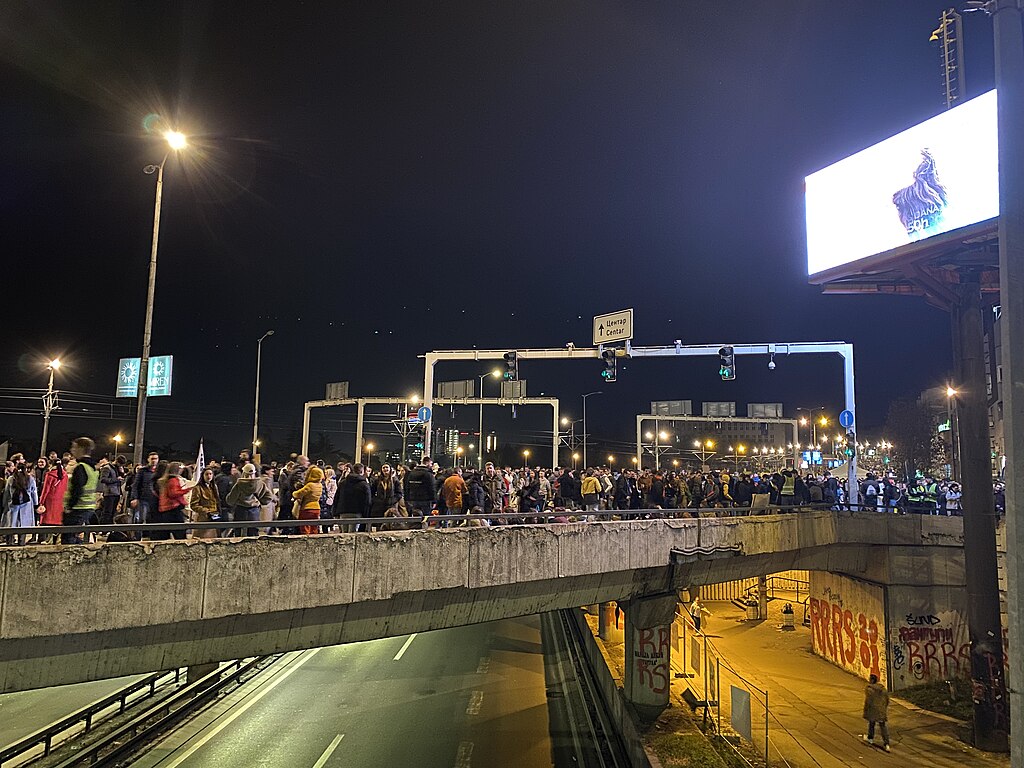
For us nearby observers, the events in Serbia over the past months cannot but carry with them a host of emotions. Most clear is a sense of hope for change in the country and solidarity towards the students and their cause, as well as an admiration for the organization of the protests and the crowds that have been gathered. There are also cloudier feelings, I think, such as a confusion about how much real change we can hope for and what a ‘successful’ end to the protests would look like. Before the protests on March 15th, for example, there was a worry that something bad could happen even though, thankfully, the demonstrations mostly remained peaceful and unimpeded—with the obvious exception of the firing of a sound cannon during a moment of silence.
There are a number of notable features of these protests: the use of democratic organizational principles, the intentional distance from opposition parties, and the simple call for a government that actually follows its own laws instead of ignoring them. The last point has a wonderful strategic irony. The oft-repeated minimal demand that institutions simply “do their jobs” sounds incredibly reasonable and achievable, yet the creation of actually independent institutions would make the existence of the Vučić regime immediately impossible. If that weren’t true, the state would simply release all the documents and contracts related to the collapse of the railway station in Novi Sad, as the law says they must.
I believe, however, that I can assume readers are familiar with the facts surrounding the protests. That’s why I want to spend a few moments looking at the concept of ‘Protest’ in 2025 in more general and global terms. The world is different than it was in many ways, and the structure of the way we live has impacts on what masses of people can achieve and what strategies/tactics can most effectively create change. In the space we have here, it’s obviously impossible to fully examine such huge trends. But what I have in mind is fairly obvious1; the increasing virtualization of our societies, the isolation of each of its members, and the dystopian technologies of facial recognition and goddamn sound-energy-ray-cannons that governments have access to.
Positively, we can remark that the event of a protest (and especially sustained occupations of spaces) is fundamentally opposed to those disturbing societal trends. An anecdote I read in a Serbian-language BBC article makes the point succinctly: “Dejan je na blokadama pronašao mnogo novih prijatelja. Prethodno je kolege sretao samo u prolazu, a sada provode dane zajedno. „Pored svega što blokade donose, ovo je prilika da nađemo ljude slične nama”, veruje on.”2 The consequences of the virtualized world—the lessening of connections and spontaneity with others in our immediate surroundings that we’ve all felt—are incompatible with protest (as the occupation of space by people).
On the negative side, though, I don’t think that we fully understand the way that new technologies and social structures impact the power of protests to change systems—it’s fairly uncharted territory. Since the pandemic, there have been several large movements, from Black Lives Matter in America to Pro-Palestine marches internationally to the recent anti-government protests in Georgia. States have responded to these movements with various levels and types of repression, and have largely ignored the demands made.
Years ago, during the Arab Spring, it was common to hear about how the revolutions that took place were ‘internet’ or ‘Twitter revolutions.’ The expectation was that social networks would enable the mobilization of people and lead to many more successful revolutions. I won’t say that the instantaneous and free communication offered on social media cannot contribute to the organization of mass action, but the world that pervasive social media has created (and whose owners want to solidify further) is not necessarily one that is conducive to protest.
Whether systems are more or less vulnerable to protest is not an easy question to answer at the present moment, we need more time and more experience to see. The actions of students in Serbia are essential, laudatory, and a necessary part of pushing against the forces that protect corrupt and unrepresentative political power.
– May 2025
- In a longer essay, I’d put it that the principle of “social distancing” was in the works well before the descent of the pandemic. If you happen to be interested, read a bit of the Frankfurt School on the “atomization” of human beings in the modern world. [↩]
- Kristina Kljajić, “Dva meseca blokada fakulteta u Srbiji: Studentski dnevnik.” BBC. [↩]
